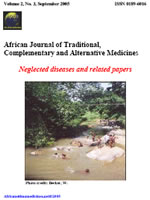
|
African Journal of Traditional, Complementary and Alternative Medicines
African Ethnomedicines Network
ISSN: 0189-6016
Vol. 12, No. 5, 2015, pp. 135-144
|
 Bioline Code: tc15107
Bioline Code: tc15107
Full paper language: English
Document type: Research Article
Document available free of charge
|
|
|
African Journal of Traditional, Complementary and Alternative Medicines, Vol. 12, No. 5, 2015, pp. 135-144
| en |
EVALUATION OF TOPICAL ANTIMICROBIAL OINTMENT FORMULATIONS OF ESSENTIAL OIL OF LIPPIA MULTIFLORA MOLDENKE
Oladimeji, Francis Abiodun; Akinkunmi, Ezekiel Olugbenga; Raheem, Abiola Ibrahim; Abiodun, Gbemisola Omotola & Bankole, Victor Oloruntoba
Abstract
Background: Essential oil of Lippia multiflora (lippia oil) has been reported to possess antibacterial and antifungal activities. This study was
aimed at developing an effective topical formulation of the oil for the treatment of skin infections.
Materials and Methods: Lippia oil was extracted from leaves of L. multiflora by hydrodistillation. Different concentrations of the oil were
incorporated into six different ointment bases. Tween 80 was incorporated at different concentrations into ointments containing 10 %w/w lippia
oil; a concentration at which minimum antimicrobial activity was observed in the ointment bases. The viscosity, spreadability and stability of the
formulations were determined. Antimicrobial activities of lippia oil in the formulations were determined against selected bacteria and fungi
using the agar diffusion assay method. 10 %w/w salicylic acid formulations were used as reference products.
Results: Incorporation of lippia oil into the ointment bases led to reduction in their viscosity with increase in spreadability. None of the
formulations showed antimicrobial activity at lippia oil content ≤ 5 %w/w. Inclusion of Tween 80 in the formulations significantly increased the
antimicrobial activities of the oil (P<0.05). The antimicrobial activities of 10 %w/w lippia oil formulated in absorption bases containing 6 %w/w
Tween 80 was significantly higher (P<0.05) than those formulated in hydrophobic bases. Lippia oil ointment formulations showed greater
antimicrobial activities than salicylic acid ointments. Two of the lippia oil ointment formulations bled when subjected to centrifugal force.
Conclusion: Ointment formulations of lippia oil (10 %w/w) in absorption base (Hydrous Wool fat Ointment BP or Simple Ointment BP)
containing 6 %w/w Tween 80 were found stable and very effective in inhibiting growth of selected pathogens implicated in skin infections.
Keywords
Lippia multiflora; Essential oil; Ointment formulation; Antimicrobial activity
|
| |
© Copyright 2015 - African Journal of Traditional, Complementary and Alternative Medicines
Alternative site location: http://journals.sfu.ca/africanem/index.php/ajtcam
|
|
